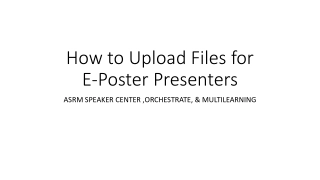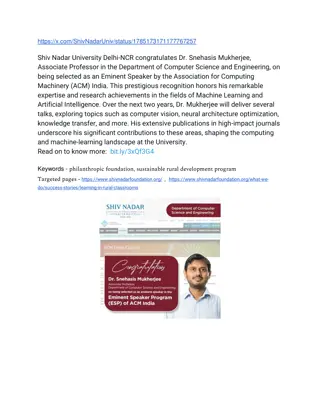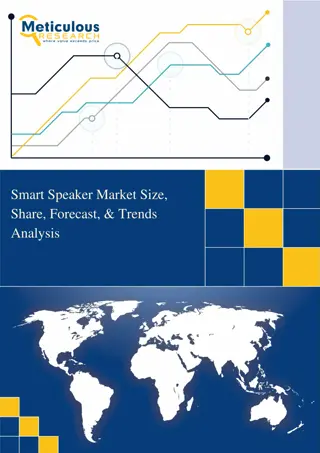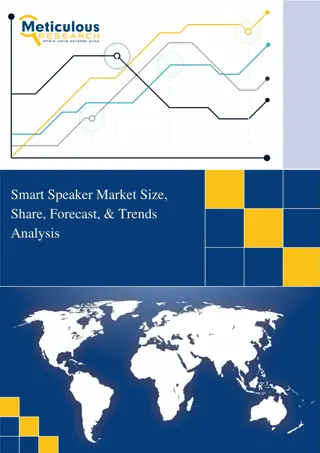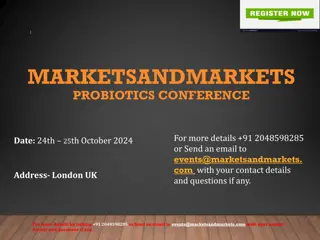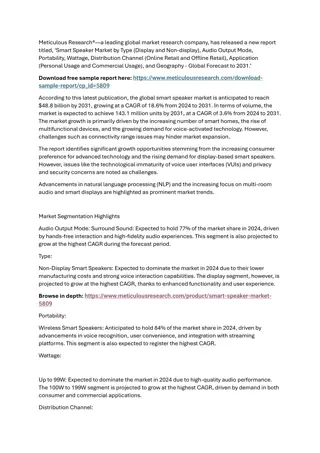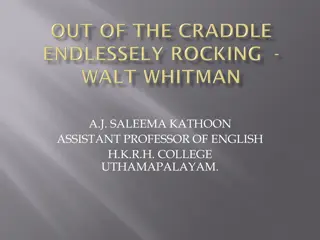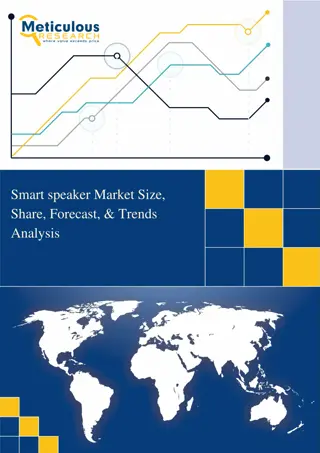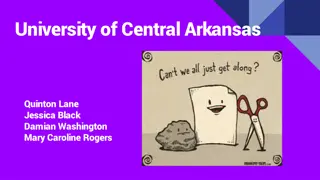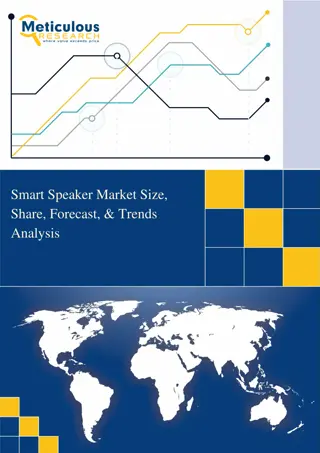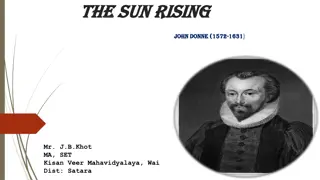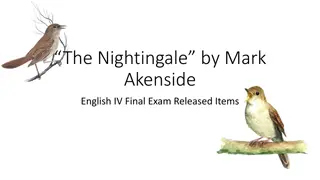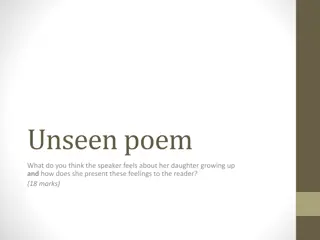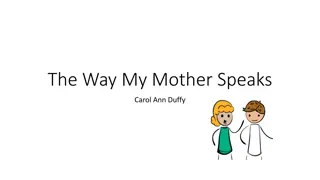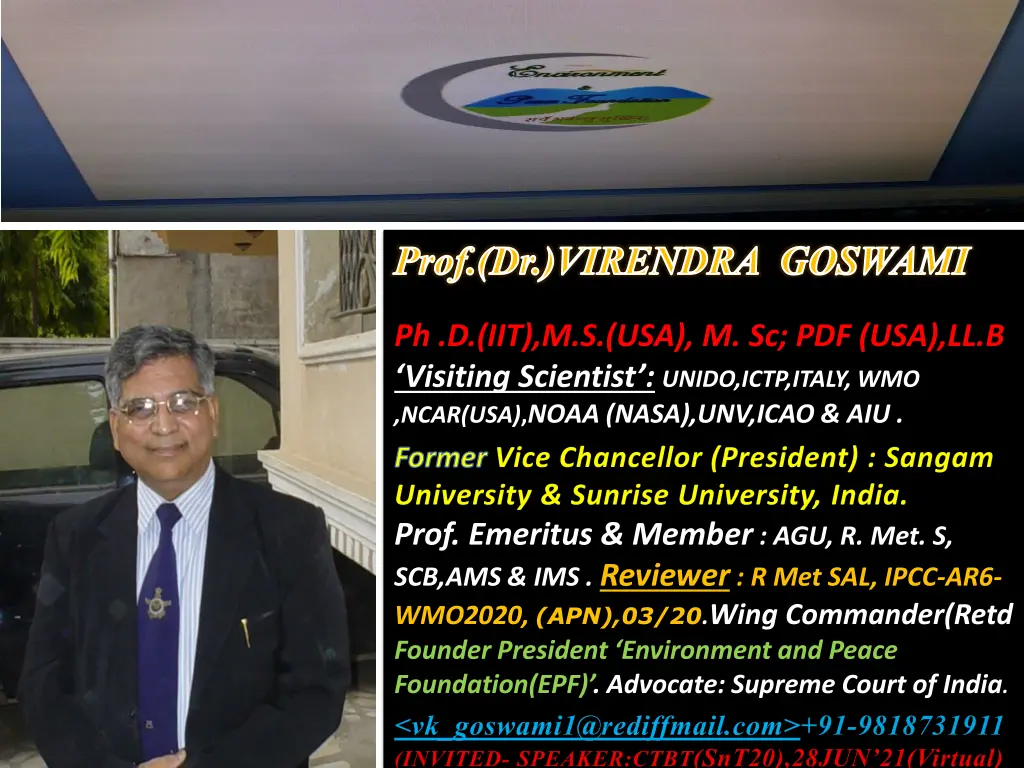
**Arctic Climate Change Study**
High Resolution Satellite Study of Multiple Stressors in Arctic Marine Systems and Correlation of Ocean-Atmosphere Cryosphere Interactions to Develop Arctic Ocean Climate. Overview of the impacts of climate change and global warming on the environment, agriculture, water availability, sea levels, and natural disasters. Discussion on the economic losses and future projections related to climate change and global warming.
Download Presentation

Please find below an Image/Link to download the presentation.
The content on the website is provided AS IS for your information and personal use only. It may not be sold, licensed, or shared on other websites without obtaining consent from the author. If you encounter any issues during the download, it is possible that the publisher has removed the file from their server.
You are allowed to download the files provided on this website for personal or commercial use, subject to the condition that they are used lawfully. All files are the property of their respective owners.
The content on the website is provided AS IS for your information and personal use only. It may not be sold, licensed, or shared on other websites without obtaining consent from the author.
E N D
Presentation Transcript
Prof.(Dr.)VIRENDRA GOSWAMI Ph .D.(IIT),M.S.(USA), M. Sc; PDF (USA),LL.B Visiting Scientist :UNIDO,ICTP,ITALY, WMO ,NCAR(USA),NOAA (NASA),UNV,ICAO & AIU . Former Vice Chancellor (President) : Sangam University & Sunrise University, India. Prof. Emeritus & Member : AGU, R. Met. S, SCB,AMS & IMS . Reviewer : R Met SAL, IPCC-AR6- WMO2020, (APN),03/20.Wing Commander(Retd Founder President Environment and Peace Foundation(EPF) . Advocate: Supreme Court of India. <vk_goswami1@rediffmail.com>+91-9818731911 (INVITED- SPEAKER:CTBT(SnT20),28JUN 21(Virtual)
High Resolution Satellite Study of Multiple High Resolution Satellite Study of Multiple Stressors in Arctic Marine Systems & Stressors in Arctic Marine Systems & Correlation of Ocean Correlation of Ocean- -Atmosphere Atmosphere Cryosphere Interactions with Climate Cryosphere Interactions with Climate Variability To Develop Arctic Ocean Climate Variability To Develop Arctic Ocean Climate - -Numerical Predicting Models Numerical Predicting Models (AOC (AOC- -NPM) NPM) . . <INVITED PRESENTER:ID #45 at CTBT(SnT20), INDICO, SCIENCE &TECHNOLOGY CONFERENCE (Virtual),28 JUN 21.>
Only the Person having firm conviction & Iron volition can attain strength & Energy. At no stage of karma does he ever hesitate. RigVeda RigVeda
1.INTRODUCTION: CLIMATE CHANGE (UN Report-2019 & Geneva-based Global Humanitarian Forum (GHF)-May 09) @ (GHF), estimates that climate change seriously affects 325 million people every year, and be more than double in 20 years. Economics losses due to GW vis- -vis Climate Change amount to over $125 billion annually & to be $340 for 8.6 billion people, by 2030. @ Climate change is altering our environment affecting agriculture, water availability, and sea-levels. It s increasing the intensity of natural disasters, rate of species extinction& diseases. @The average decade temp. of the globe has augmented more than 10F since 1900.This increase in earth s average temperature is called Global Warming. @ Lacking big curbs in GHG discharges, the 21st century temperatures will rise 3 to 8 degrees, climate patterns piercingly shift, ice sheets contract and Seas rise.
1. INTRODUCTION: EFFECTS OF CLIMATE CHANGE (GLOBAL WARMING) @Univ. of Washington Report (Aug 17): envisage that the World will reach tipping point (2deg.C temp.) & 4.9 deg. C by the end of century resulting unstoppable destructive Climate Change. @ The effects of Climate Change are: *Melting Ice and Rising Sea Level, *Changes in Rainy Patterns & Agriculture. @Increased concentration of CO2 is due to: Burning fossil fuels in cars, industry and homes Deforestation & Burning of forests Deforestation, land degradation, water and air pollution add to GHG emissions. The anthropogenic greenhouse gases are hydrofluorocarbons (HFC), perfluorocarbons (PFC) and Chlorofluorocarbons (CFC).
1.INTRODUCTION (Chemical Contaminants, Contaminated , Global Warming & Climate Change) @Types of Chemical Contaminants: Chemical Contaminants can be separated into eight contaminant groups as follows: Nonhalogenated volatile organic compounds (VOCs). Halogenated volatile organic compounds. Nonhalogenated semivolatile organic compounds (SVOCs). Halogenated semivolatile organic compounds Fuels. Inorganics.Radionuclides.Explosives. @The contaminated water not only give rise to water born diseases but, also results Climate change is altering our environment affecting agriculture, water availability, and sea-levels. It s increasing the intensity of natural disasters like Tsunami, Cyclonic Storms ,droughts, floods, species extinction particularly marine live & diseases. The too much water causes River Banking Erosion while too less water affects Water Management, River Water Channelization & Dams& Rise of Sea level due to Global Warming i.e. Climate Change.
1.INTRODUCTION:Arctic Ocean Climate- Numerical Prediction Models (AOC-NPM) @ The seminal scientific research is needed to develop Arctic Ocean Climate- Numerical Prediction Models (AOC- NPM), to understand the major Atmospheric challenges due to extreme weather events caused due to mesoscale convective systems, Global Carbon Cycle, Ocean Salinity, and Marine Pollution resulting due to the toxin, toxic gases, Global Warming (due to Green House Gases) over the Cryosphere (Arctic),Oceanic and sub-surface Oceanic and Atmospheric regions. @The term cryosphere comes from the Greek word, krios, which means cold e. g. Arctic, Greenland & Antarctica regions. The Canadian Scientists in 2016 found that the Ocean- Atmosphere- Cryosphere (OAC) interaction is more evident on North pole i. e. Arctic regions.
2.BACKGROUNG & RELEVANCE TO PREVIOUS WORK @In Feb 17, Researchers found that the unstoppably melting of the glacier into the ocean mainly because of warmer seawater lapping at its underside. @ Prof. Peter Clark, OSU attributed that the Glacier retreat was due to rising levels of Carbon Dioxide and other GHG, as opposed to other types of forces. If, this continues then the most of Glaciers would disappear in the next few centuries & the Glaciers loss in future will be contributing to rising sea levels, environmental pollution vis- -vis Climate Change. @The Ocean Circulations, Ocean-Atmospheric- Cryosphere (OAC) interactions, and the inorganic contaminants get affected by the Ocean Salinity, affecting Changing Water Carbon Cycles, marine biogeochemistry and affecting the marine life.
2.BACKGROUNG & RELEVANCE TO PREVIOUS WORK @ HT 17 reported that the particles in the polluted air can travel from lungs into our blood stream resulting the increase of risk of heart attack or strokes since Nanoparticles in air pollution have been associated with cardiovascular disease leading to premature death. As per the State of Global Air 2017 Report, released in Boston on 14 Feb 17, as many as 2.54 lakhs death occurred in 2015 on account of exposure to ozone and its impact on chronic lung disease. @In May 17 Canada, Prof. Pierre Berube has developed a low maintenance water filtration system using the technology which combines microbes and gravity using ultra-filtration membranes, which is very fine screen that removes not just particulate matter but, also large molecules ,e .g. disinfectants or herbicides, pesticides and contaminants from water e.g. microbial pathogens, viruses and bacteria
3.RESEARCH METHODOLOGY & PROCEDURE TO BE FOLLOWED. @ It s imperative to investigate sub mesoscale dynamics of Arctic ice sheet stability, ice and bedrock coring, ice sheet modelling, and ice sheet processes viz. physical, chemical, and biological oceanographic for climate modelling study through the computation of Correlation of Cryosphere Ice Sheet Stability with Sea-level Variability Mechanism ,Sub-Mesoscale Dynamics and Climate variability by developing Ocean Systems Interactions, Risks, Instabilities and Synergies (OSIRIS) & Arctic Ocean Climate Numerical Predicting Models (AOC-NPM). @ The kinematic features of the mesoscale convective systems over Arctic- Ocean regions would be correlated with ocean-atmosphere- cryosphere variability on time & Space Scales; at the local, regional and global levels through the extracted Sea Surface Temperature (SSTs) over the grid box , attributing the regional change to natural and anthropogenic radiative forcing agents to bring out the few optimum values of these to develop (OSIRIS) & Arctic Ocean Climate Numerical Predicting Models (AOC-NPM), by using High Resolution Satellite imageries, data access, assimilation; HPC and cloud computing for real-time analysis.
3.RESEARCH METHODOLOGY & PROCEDURE TO BE FOLLOWED (Continued). @ Efforts are to be put into the Co-evolution of climate and marine life in the Arctic-Sea through the Correlation of Ocean-Atmosphere-Cryosphere interactions with Climate Variability and save Mother Earth from Environmental Pollution for the present and future generations. @The impacts of multiple stressors on the ocean and the associated risks of abrupt state shifts, rising of sea level, melting of the glaciers, Arctic Ocean regional Variability of the Sub-Mesoscale Dynamics vis- -vis Climate Variability, would be evaluated by examining the High-Resolution Satellite Imageries with emphasis on the large scale Kinematic and Thermodynamic behavior of selected mesoscale convective systems.
3.RESEARCH METHODOLOGY & PROCEDURE TO BE FOLLOWED (Contd). @ It s imperative to analyse Satellite imageries (IR & VR) over the Cryosphere (Arctic Ocean), Oceanic regions (Pacific) comprising Transitional areas (TAs) & (WBCs). @ The understanding of impacts of multiple stressors on the ocean and the associated risks of abrupt state shifts can be explored through the comprehensive studies of Ocean Systems Interactions, Risks, Instabilities and Synergies (OSIRIS). @Three to six hours Sounding (Surface) and Drop-Sounding, would be analysed in time section of temperature anomaly, relative humidity and equivalent potential temperature. @ Also , the Time Series plot of 0300 UTC Surface Pressure Gradient; between a few selected stations falling at almost the same latitude and longitude, to bring out the few optimum values of these parameters would be used to develop (AOC-NPM).
3.RESEARCH METHODOLOGY (AOC-NPM) & (Remediation of Water Pollution). @ The integration of Satellite and Surface Sounding data would be accomplished through plausible model in which the section strips are treated as space sections. @ The physicochemical and spectroscopic methods would be used to characterize the in-situ chemical speciation of the inorganic contaminants and develop technologies for remediation of Water Pollution by catalytic-oxidants, and by regeneration of Granular Activated Carbon (GAC) using High Affinity Toxin Receptors (HART) to entrap toxins. @The process of Initialization, Computation, Parameterization, within the (1 x 1) deg. grid-box by the computer algorithm, would be employed in order to develop the (AOC-NPM) by using Satellite data fitted with Lightning sensors & CubeSats carrying high- frequency passive microwave sensors.
3.RESEARCH METHODOLOGY (Procedural Steps for Development of Operational (AOC-NPM) @ Procedural steps for development of Operational (AOC-NPM) *Improvements to vortex initialization and data assimilation * Improvements to Cryosphere-Ocean-Atmospheric Physics *Increase/change vertical resolution, nested domain sizes. *Replace (AOCPM) with (AOC-NPM) System. *Three-way Atmosphere-Ocean-Wave coupling *Basin-scale configurations @ Next, to attribute the regional change to natural and anthropogenic radiative forcing agents, the few optimum values of the kinematic features of the mesoscale convective systems over Arctic- Ocean would be correlated with ocean-atmosphere- cryosphere Climate variability on time, and space scales; at the local, regional, and global levels through the extracted Sea Surface Temperature (SSTs) over the grid box, in the specified domain .
4.General Methodology:Water Treatment Processes (Oxydation Processes) @Next, the Oxidation process would be employed in subsurface systems and in above ground water treatment systems involving chemical oxidation regeneration of Granular Activated Carbon (GAC) & to treat Groundwater contaminants by making use of the chemical oxidant s viz. hydrogen peroxide, persulfate, permanganate & ozone causing chemical destruction of toxic organic chemicals. @To entrap Chemical toxicants (lead, mercury, hydrofluoric acid, chlorine gas, and methyl alcohol), the High Affinity Toxin Receptors (HART) would be developed. @Also, physicochemical and spectroscopic methods are to be employed to characterize the in-situ chemical speciation of the inorganic contaminants and Catalytic Oxidants (hydrogen peroxide, persulfate, permanganate & ozone) to control Water&Environmental pollution as well as to investigate process fundamentals and assess contaminant transformation through Chemical Reaction Kinetics.
4.General Methodology:Water Treatment Process @ Remediation of Water Treatment Process (WTP): by making use of catalytic chemical oxidants: It has been observed that matching the oxidant and in situ delivery system to the contaminants of concern (COCs) and the site conditions is the key to successful implementation and achieving best results in Water Treatment Process . @ In situ treatments the ground water is treated without being brought to the surface. These processes are slower but economical. The general methods and procedures to be followed for remediation of Water treatment processes.
4.General Methodology: Water Treatment Processes(PRT & CRT). @ Physical/Chemical Remediation Water Treatment Technologies.(PRT ):The Physical Remediation Technology (PRT) involves the use of physical properties of the contaminants and separation of contamination. @ In Chemical Remediation Technology (CRT); the contaminated medium is destroyed by Chemically Convert (CC).It may use Chemical oxidant and Catalytic Oxidants to either separate the contaminants or destroy the contamination. Passive treatment walls separate and destroy the contaminant from in situ ground water. PRTs are economical than CRTs. @ In the CRTs (i.e. Chemical oxidation )due attention be paid to reaction chemistry and transport processes and management of remediation wastes.
4.General Methodology: Water Treatment Processes (PRT & CRT). @ This investigation intends to employ the following well tested PRTs & CRTs as regards ground water, surface water, and leachate: # air sparging & bio slurping, # directional wells & dual phase extraction, # thermal treatment & hydrofracturing, # in-well air stripping & passive/reactive treatment walls. @The rate and extent of degradation of a target COC are dictated by the properties of the chemical itself and its susceptibility to oxidative degradation.
4.General Methodology: Water Treatment Processes.(Matrix Conditions) & (Ozone Oxidation) @ Matrix conditions e.g., pH, temperature, the concentration of oxidant, and the concentration of other oxidant-consuming substances ( e. g. organic matter, reduced minerals, carbonate and other free radical scavengers.) @ In these processes; Oxidant delivery systems often employ vertical or horizontal injection wells and sparge points with forced advection to rapidly move the oxidant into the subsurface. @Ozone Oxidation: Ozone gas oxidizes contaminants directly or through the formation of hydroxyl radicals e.g. peroxide.These reactions are most effective in systems with acidic pH. Ozone oxidation reaction proceeds with extremely fast, pseudo first order kinetics. Due to ozone s high reactivity and instability, O3is produced onsite, and it requires closely spaced delivery points (e.g., air sparging wells).
4.General Methodology: Water Treatment Processes (Ozone Oxidation) Continued. @ Composition of the ozone can lead to beneficial oxygenation and bio stimulation. @ Peroxide Oxidation i.e. Fenton s Reagent oxidation :Oxidation using liquid hydrogen peroxide (H2O2) in the presence of native or supplemental ferrous iron (Fe+2) produces Fenton s Reagent which yields free hydroxyl radicals (OH-). @These strong, nonspecific oxidants can rapidly degrade a variety of organic compounds. Fenton s Reagent oxidation is most effective under very acidic pH (e.g., pH 2 to 4) and becomes ineffective under moderate to strongly alkaline conditions. The reactions are extremely rapid and follow second-order kinetics.
4.General Methodology: Water Treatment Processes (To Save Underwater Marine life). @Dr.VK Goswami et.al. found that catalytic oxides of first row transition metal oxides e.g. Cobalt oxide should optimize the process of subsurface remediation and above-ground water treatment systems depending on a variety of site-specific conditions e.g. reaction rate kinetics. @ Hence , the efforts are focused to discuss strategies to save underwater marine life and environment by controlling Water & Environmental pollution resulting due to toxins (chemical, biological, physical and radiation), toxic gases(GHG,CO), by Catalytic oxides of first row transition metal oxides and employing High Affinity Toxin Receptors (HART)for depolluting water& detoxifying GHG (CH4, CO2,N2O,CFC ), e.g. converting CH4 to ethanol by catalytic processes and developing hybrid fuels like bio-ethanol and bio-diesel and go for electricity from biomass as well as to subsequent bioremediation. @ Next, to evaluate correlation of chemical oxidants with chemical species associated with soil and aquifer materials, and with target and non-target contaminants during water treatment processes.
4.General Methodology:(Correlational Predictive Model of Chemical Reaction Kinetics(MCRK) @Next, to evaluate correlation of chemical oxidants with chemical species associated with soil and aquifer materials, and with target and non-target contaminants during water treatment processes. @ to develop physicochemical and spectroscopic methods to characterize the in-situchemical speciation of the inorganic contaminants, to entrap water contaminants,toxins, and develop @Catalyst Absorption Beds, carbon sinks , Cobalt Oxide Catalyst Converters for limiting Green House Gases (CO2, CH4, CO, H2, N2O, SF6, 14CO2) and inhibit the generation and widespread release of toxic chemical substances in waterbodies and optimize the remediation of water treatment process by chemical oxidation & regeneration of granular activated carbon (GAC) to save marine life . @ Finally, develop Correlational Predictive Model of Chemical Reaction Kinetics(MCRK) in order to investigate process fundamentals & assess contaminant transformation.
5.Remediation of Environmental Pollution (REP) @Goswami V.K et. al have shown that the few oxides of first row of transition metals viz. Cobalt Oxides : CoO ( Co0I, Co0II, CoOI,II,) CO2O3; CO3O4 with high values of Magnetic Susceptibility, high Surface area ,highest activation energy & high Catalytic activity exhibits dramatic heating and cooling when a magnetic field is applied and removed, at normal conditions by providing highly efficient cooling at room temperatures, and does not loose efficiency when the cooling cycle is repeated time after time. @ Mitigation of emission of CO2 :(a)Plantation: plants are the best absorbent of CO2 Each tree planted in the humid tropics absorbs 50 pounds (22 kg) of carbon dioxide every year. (b) Control Anthropogenic Activities (c) GHG(Methane) To Ethanol By Catalytic Processes.(d) Non-Conventional Energy.(Nuclear, Electric, Wind, Water, & Solar energy ).Expand renewable and clean energy technologies viz. Power Generation from Biomass , reducing the use of Ozone Depleting Substances ,and Carbon Emissions .
5.Remediation of Environmental Pollution (REP) @Mitigation of emission of CO2 By pollution control devices e.g Absorption beds(CoO), carbon sinks , HART, Catalyst Converters, etc., for limiting Green House Gases(Catalyst- beds . @ LUNAR COOLING: I m of the view that Lunar Energy can be harnessed and used for Cooling and production of Lunar Ac and refrigeration as well. Lunar Cooling can be generated by either harnessing the Lunar energy through Lunar Panels alike Solar panels or developing the Lunar Concentrator by using a parabolic trough like machine, perhaps complete with methanol and activated Carbon attached on the top. In all probability this proposed system of Lunar Concentrator comprising methanol and activated Carbon should minimize Green House effect, thereby increasing the Cooling process. remediation of water contamination treatment &detoxification of toxins may be used to develop Correlational Predictive Model of Chemical Reaction Kinetics(MCRK)in order to investigate process fundamentals & assess contaminant transformation.
6.SCOPE:(Water Car & Water Harnessing From Fog & Humid Atmosphere (Feb 2020) @ Lately, A Car has been run on Water energy in Gujrat, India. @ By using specially designed Mesh-Curtains, the fog particles i.e. Low clouds are entrapped, and water is produced. @ Also, by condensation of water available in the humid atmosphere the water has been produced by Indian Innovators. Water ATM s machines may be designed in future. @ Tree plantation Drone developed by BioCarbon Engg,Australia. @ (InJul 20), Zero Mass Water: US firm uses technology to harvest drinking water out of thin air, using a combination of materials science, solar power, and predictive data. @ In Dubai , UAE Arabian Desert, A US-based Zero Mass Water , firm harvests drinking water out of thin air, using a combination of materials science, solar power, and predictive data , instead of the traditional method of drilling wells into the ground or purifying seawater. THANKS & STAY BLESSED


